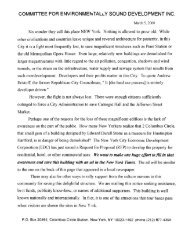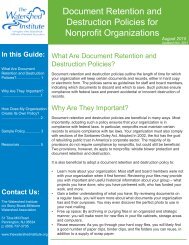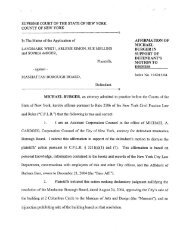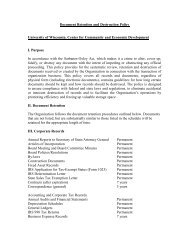Save the Date! - The New York Preservation Archive Project
Save the Date! - The New York Preservation Archive Project
Save the Date! - The New York Preservation Archive Project
Create successful ePaper yourself
Turn your PDF publications into a flip-book with our unique Google optimized e-Paper software.
Burnham Collection Intact!<br />
<strong>Preservation</strong> Papers Rescued from Auction Block<br />
By Elizabeth R. Jeffe, Vice-Chair<br />
Pennsylvania Station, track level, <strong>New</strong> <strong>York</strong>, N.Y.;<br />
Courtesy of Detroit Publishing Company<br />
Penn Station<br />
Doc Nearing<br />
Completion<br />
A half-century after <strong>the</strong> original Pennsylvania<br />
Station was slated for demolition, <strong>the</strong><br />
magnificent structure survives only in<br />
<strong>the</strong> City’s memory, but its loss remains a<br />
milestone in <strong>New</strong> <strong>York</strong> City’s preservation<br />
history. This legacy is captured in “<strong>The</strong> Rise<br />
and Fall of Pennsylvania Station,” a onehour<br />
documentary directed by photographer<br />
and preservationist Michael Tramis. <strong>The</strong> film<br />
includes interviews with such notable figures<br />
as David Childs, Vincent Scully, Philip<br />
Johnson, Paul Goldberger, and Hilary Ballon.<br />
Demonstrating <strong>the</strong> dynamism of archival<br />
material, <strong>the</strong> film brings Penn Station back to<br />
life through stock film footage, never-beforeseen<br />
private collections of still images, and<br />
scenes from classic movies featuring Penn<br />
Station, as well as original 3D graphics that<br />
create a virtual tour through <strong>the</strong> lost station.<br />
<strong>Project</strong>ed for completion in late 2011, <strong>the</strong><br />
documentary is intended to be presented<br />
on television as <strong>the</strong> first of a series on<br />
demolished buildings of <strong>New</strong> <strong>York</strong> City.<br />
However, until now <strong>the</strong> project has been<br />
funded solely by <strong>the</strong> filmmaker, and a<br />
fundraising goal of $200,000 remains to<br />
cover post-production costs. Sponsored<br />
by <strong>the</strong> <strong>New</strong> <strong>York</strong> Foundation for <strong>the</strong> Arts,<br />
<strong>the</strong> team is seeking tax-deductible financial<br />
contributions to ensure that <strong>the</strong> project<br />
can be fully realized. To learn more, make<br />
a donation, or view <strong>the</strong> trailer online, please<br />
visit www.pennstationdoc.com.<br />
Those who are passionate about preservation<br />
undoubtedly know about <strong>the</strong> incredible legacy<br />
of Alan Burnham (1913-1984). A practicing<br />
architect, architectural historian, and<br />
ardent preservationist, Burnham authored<br />
<strong>New</strong> <strong>York</strong> Landmarks: A Study & Index of<br />
Architecturally Notable Structures in Greater <strong>New</strong><br />
<strong>York</strong>. Published in 1963, this magnificent<br />
illustrated volume remains a masterwork in<br />
<strong>the</strong> preservationist canon. Two years later,<br />
Burnham capped off his illustrious career in<br />
preservation by becoming <strong>the</strong> first executive<br />
director of <strong>the</strong> <strong>New</strong> <strong>York</strong> City Landmarks<br />
<strong>Preservation</strong> Commission.<br />
What many people probably do not know<br />
is <strong>the</strong> inspiring story of how Burnham’s<br />
collection of architectural and preservation<br />
books and personal papers, which became<br />
known as <strong>the</strong> American Architectural<br />
<strong>Archive</strong> (AAA), was rescued from <strong>the</strong><br />
auctioneer’s block through <strong>the</strong> efforts of<br />
Jeffrey Lew. In 2008, just as <strong>the</strong> AAA was<br />
headed for sale piece by piece, Jeff stepped<br />
in and bought <strong>the</strong> collection in its entirety for<br />
<strong>the</strong> sake of preservation posterity. NYPAP<br />
In <strong>the</strong> Foreword to Alan Burnham’s <strong>New</strong> <strong>York</strong><br />
Landmarks (cover image shown above), Brendan Gill<br />
describes it as “a veritable Kama Sutra, or manual of<br />
instruction, in <strong>the</strong> wooing of this incomparable city.”<br />
became a critical partner in <strong>the</strong> second<br />
part of this rescue effort by helping Jeff<br />
find a repository at Columbia University’s<br />
Avery Library for <strong>the</strong> portion of <strong>the</strong> AAA<br />
consisting of Burnham’s papers.<br />
Jeff, a <strong>New</strong> <strong>York</strong> real estate broker and<br />
investor, came to his mission through<br />
his association with Gordon McCollum,<br />
whose commercial real estate firm, <strong>The</strong><br />
Galbreath Company, hired Jeff when he<br />
graduated from college in 1989. Jeff had<br />
<strong>the</strong> opportunity to work with McCollum<br />
on a number of projects, and he became,<br />
in Jeff ’s words, “absolutely <strong>the</strong> catalyst for<br />
my interest in preservation.” An activist in<br />
<strong>the</strong> world of <strong>New</strong> <strong>York</strong> City preservation,<br />
McCollum purchased a townhouse on<br />
Prince Street in SoHo that he fully restored,<br />
painstakingly combing <strong>the</strong> country to find<br />
<strong>the</strong> architecturally correct components for<br />
his renovation. Having known Burnham<br />
personally, and understanding <strong>the</strong> importance<br />
of Burnham’s role in preservation,<br />
McCollum purchased Burnham’s collection<br />
of books and papers when Burnham died<br />
in 1986. McCollum used his Prince Street<br />
home as <strong>the</strong> repository of <strong>the</strong> Burnham<br />
collection and did much more than just<br />
save <strong>the</strong> AAA—he made <strong>the</strong> materials<br />
available to researchers. McCollum’s library,<br />
containing <strong>the</strong> Burnham collection, became<br />
a focal point for preservationists to ga<strong>the</strong>r<br />
and study. Because of Jeff ’s friendship with<br />
McCollum, and his familiarity with <strong>the</strong> AAA<br />
in McCollum’s house, Jeff Lew was fully<br />
aware of both <strong>the</strong> importance of his friend’s<br />
role as a steward of preservation history,<br />
and <strong>the</strong> incredible value of <strong>the</strong> collection<br />
itself. According to Jeff, <strong>the</strong> AAA included<br />
“entire filing cabinets” of materials such<br />
as correspondence and proposals that had<br />
belonged to Burnham; <strong>the</strong>se included a<br />
“tremendous amount of data,” something of<br />
particular value to preservationists who need<br />
hard facts to make <strong>the</strong> case for preservation<br />
initiatives.<br />
When Gordon McCollum died in January<br />
of 2000, <strong>the</strong> McCollum family retained <strong>the</strong><br />
Page 6







